Topical Advisory Panel applications are now closed. Please contact the Editorial Office with any queries.
Journal Description
Information
Information
is a scientific, peer-reviewed, open access journal of information science and technology, data, knowledge, and communication, and is published monthly online by MDPI. The International Society for Information Studies (IS4SI) is affiliated with Information and its members receive discounts on the article processing charges.
- Open Access— free for readers, with article processing charges (APC) paid by authors or their institutions.
- High Visibility: indexed within Scopus, ESCI (Web of Science), Ei Compendex, dblp, and other databases.
- Journal Rank: CiteScore - Q2 (Information Systems)
- Rapid Publication: manuscripts are peer-reviewed and a first decision is provided to authors approximately 16.4 days after submission; acceptance to publication is undertaken in 3.8 days (median values for papers published in this journal in the second half of 2024).
- Recognition of Reviewers: reviewers who provide timely, thorough peer-review reports receive vouchers entitling them to a discount on the APC of their next publication in any MDPI journal, in appreciation of the work done.
Impact Factor:
2.4 (2023);
5-Year Impact Factor:
2.6 (2023)
Latest Articles
YOLO-LSM: A Lightweight UAV Target Detection Algorithm Based on Shallow and Multiscale Information Learning
Information 2025, 16(5), 393; https://doi.org/10.3390/info16050393 - 9 May 2025
Abstract
To address challenges such as large-scale variations, high density of small targets, and the large number of parameters in deep learning-based target detection models, which limit their deployment on UAV platforms with fixed performance and limited computational resources, a lightweight UAV target detection
[...] Read more.
To address challenges such as large-scale variations, high density of small targets, and the large number of parameters in deep learning-based target detection models, which limit their deployment on UAV platforms with fixed performance and limited computational resources, a lightweight UAV target detection algorithm, YOLO-LSM, is proposed. First, to mitigate the loss of small target information, an Efficient Small Target Detection Layer (ESTDL) is developed, alongside structural improvements to the baseline model to reduce parameters. Second, a Multiscale Lightweight Convolution (MLConv) is designed, and a lightweight feature extraction module, MLCSP, is constructed to enhance the extraction of detailed information. Focaler inner IoU is incorporated to improve bounding box matching and localization, thereby accelerating model convergence. Finally, a novel feature fusion network, DFSPP, is proposed to enhance accuracy by optimizing the selection and adjustment of target scale ranges. Validations on the VisDrone2019 and Tiny Person datasets demonstrate that compared to the benchmark network, the YOLO-LSM achieves a mAP0.5 improvement of 6.9 and 3.5 percentage points, respectively, with a parameter count of 1.9 M, representing a reduction of approximately 72%. Different from previous work on medical detection, this study tailors YOLO-LSM for UAV-based small object detection by introducing targeted improvements in feature extraction, detection heads, and loss functions, achieving better adaptation to aerial scenarios.
Full article
(This article belongs to the Special Issue Addressing Real-World Challenges in Recognition and Classification with Cutting-Edge AI Models and Methods)
►
Show Figures
Open AccessArticle
SYNCode: Synergistic Human–LLM Collaboration for Enhanced Data Annotation in Stack Overflow
by
Meng Xia, Shradha Maharjan, Tammy Le, Will Taylor and Myoungkyu Song
Information 2025, 16(5), 392; https://doi.org/10.3390/info16050392 - 9 May 2025
Abstract
Large language models (LLMs) have rapidly advanced natural language processing, showcasing remarkable effectiveness as automated annotators across various applications. Despite their potential to significantly reduce annotation costs and expedite workflows, annotations produced solely by LLMs can suffer from inaccuracies and inherent biases, highlighting
[...] Read more.
Large language models (LLMs) have rapidly advanced natural language processing, showcasing remarkable effectiveness as automated annotators across various applications. Despite their potential to significantly reduce annotation costs and expedite workflows, annotations produced solely by LLMs can suffer from inaccuracies and inherent biases, highlighting the necessity of maintaining human oversight. In this article, we present a synergistic human–LLM collaboration approach for data annotation enhancement (SYNCode). This framework is designed explicitly to facilitate collaboration between humans and LLMs for annotating complex, code-centric datasets such as Stack Overflow. The proposed approach involves an integrated pipeline that initially employs TF-IDF analysis for quick identification of relevant textual elements. Subsequently, we leverage advanced transformer-based models, specifically NLP Transformer and UniXcoder, to capture nuanced semantic contexts and code structures, generating more accurate preliminary annotations. Human annotators then engage in iterative refinement, validating and adjusting annotations to enhance accuracy and mitigate biases introduced during automated labeling. To operationalize this synergistic workflow, we developed the SYNCode prototype, featuring an interactive graphical interface that supports real-time collaborative annotation between humans and LLMs. This enables annotators to iteratively refine and validate automated suggestions effectively. Our integrated human–LLM collaborative methodology demonstrates considerable promise in achieving high-quality, reliable annotations, particularly for domain-specific and technically demanding datasets, thereby enhancing downstream tasks in software engineering and natural language processing.
Full article
(This article belongs to the Special Issue Advances in Machine Learning and Intelligent Information Systems)
►▼
Show Figures

Graphical abstract
Open AccessArticle
A Fully Decentralized Web Application Framework with Dynamic Multi-Point Publishing and Shortest Access Path
by
Bin Yu, Yuhui Fan, Peng Zhao, Xiaoyan Li and Lei Chen
Information 2025, 16(5), 391; https://doi.org/10.3390/info16050391 - 8 May 2025
Abstract
Decentralized applications (DApps) have found extensive use across various industries. However, they still face several issues that need to be resolved. Currently, DApps are in a semi-decentralized stage, as only partial decentralization has been achieved. This paper presents FDW, a fully decentralized web
[...] Read more.
Decentralized applications (DApps) have found extensive use across various industries. However, they still face several issues that need to be resolved. Currently, DApps are in a semi-decentralized stage, as only partial decentralization has been achieved. This paper presents FDW, a fully decentralized web application framework, which mainly includes the DWeb market, developer client, publisher client, and visitor client. The DWeb (Decentralized Web) market is established to manage all DWebs. In the DWeb market, developers can register, upload, and maintain DWebs; publishers can download, validate, and deploy DWebs; and visitors can browse DWebs and provide content. To guarantee the reliable operation of DWebs, multiple publisher nodes deploy a DWeb through dynamic multi-point publishing. By adopting the shortest access path, client nodes can efficiently access any DWeb from the closest publishing node. Additionally, the incentive and governance mechanisms encourage collaboration among all participants, ensuring the security of FDW. A prototype system of FDW has been developed, which consists of a DWeb container and an example DWeb. An analysis and evaluation of the decentralization, scalability, and security of FDW are provided. Compared with other related schemes, FDW shows certain advantages in these aspects.
Full article
(This article belongs to the Section Information Systems)
►▼
Show Figures
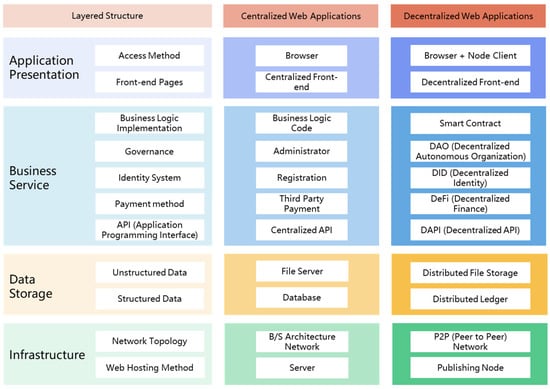
Figure 1
Open AccessArticle
A Process Tree-Based Incomplete Event Log Repair Approach
by
Qiushi Wang, Liye Zhang, Rui Cao, Na Guo, Haijun Zhang and Cong Liu
Information 2025, 16(5), 390; https://doi.org/10.3390/info16050390 - 8 May 2025
Abstract
►▼
Show Figures
The low quality of business process event logs—particularly the widespread occurrence of incomplete traces—poses significant challenges to the reliability, accuracy, and efficiency of process mining analysis. In real-world scenarios, these data imperfections severely undermine the practical value of process mining techniques. The primary
[...] Read more.
The low quality of business process event logs—particularly the widespread occurrence of incomplete traces—poses significant challenges to the reliability, accuracy, and efficiency of process mining analysis. In real-world scenarios, these data imperfections severely undermine the practical value of process mining techniques. The primary research problem addressed in this study is the inefficiency and limited effectiveness of existing Petri-net-based incomplete trace repair approaches, which often struggle to accurately recover missing events in the presence of complex and nested loop structures. To tackle these limitations, we aim to develop a faster and more accurate approach for repairing incomplete event logs. Specifically, we propose a novel repair approach based on process trees as an alternative to traditional Petri nets, thus alleviating issues such as state space explosion. Our approach incorporates process tree model decomposition and innovative branch indexing techniques, enabling rapid localization of candidate branches for repair and a significant reduction in the solution space. Furthermore, by leveraging activity information within the traces, our approach achieves efficient and precise repair of loop nodes through a single traversal of the process tree. To comprehensively evaluate our approach, we conduct experiments on four real-life and five synthetic event logs, comparing performance against state-of-the-art techniques. The experimental results demonstrate that our approach consistently delivers repair accuracies exceeding 70%, with time efficiency improved by up to three orders of magnitude. These findings validate the superior accuracy, efficiency, and scalability of the proposed approach, highlighting its strong potential for practical applications in business process mining.
Full article

Figure 1
Open AccessSystematic Review
A Systematic Literature Review on Serious Games Methodologies for Training in the Mining Sector
by
Claudia Gómez, Paola Vallejo and Jose Aguilar
Information 2025, 16(5), 389; https://doi.org/10.3390/info16050389 - 8 May 2025
Abstract
High-risk industries like mining must address occupational safety to reduce accidents and fatalities. Training through role-playing, simulations, and Serious Games (SGs) can reduce occupational risks. This study aims to conduct a systematic literature review (SLR) on SG methodologies for the mining sector. This
[...] Read more.
High-risk industries like mining must address occupational safety to reduce accidents and fatalities. Training through role-playing, simulations, and Serious Games (SGs) can reduce occupational risks. This study aims to conduct a systematic literature review (SLR) on SG methodologies for the mining sector. This review was based on a methodology inspired by the PRISMA (Preferred Reporting Items for Systematic Reviews and Meta-Analyses) guidelines. Three research questions were formulated to explore how SGs contribute to immediate feedback, brain stimulation, and training for high-risk scenarios. The review initially identified 1987 studies, which were reduced to 30 relevant publications following a three-phase process: (1) A search string based on three research questions was defined and applied to databases. (2) Publications were filtered by title and abstract. (3) A full-text reading was conducted to select relevant publications. The SLR showed SG development methodologies with structured processes that are adaptable to any case study. Additionally, it was found that Virtual Reality, despite its implementation costs, is the most used technology for safety training, inspection, and operation of heavy machinery. The first conclusion of this SLR indicates the lack of methodologies for the development of SG for training in the mining field, and the relevance of carrying out specific methodological studies in this field. Additionally, the main findings obtained from this SLR are the following: (1) Modeling languages (e.g., GML and UML) and metamodeling are important in SG development. (2) SG is a significant mechanism for cooperative and participative learning strategies. (3) Virtual Reality technology is widely used in safe virtual environments for mining training. (4) There is a need for methodologies that integrate the specification of cognitive functions with the affective part of the users for SGs suitable for learning environments. Finally, this review highlights critical gaps in current research and underscores the need for more integrative approaches to SG development.
Full article
(This article belongs to the Section Review)
►▼
Show Figures
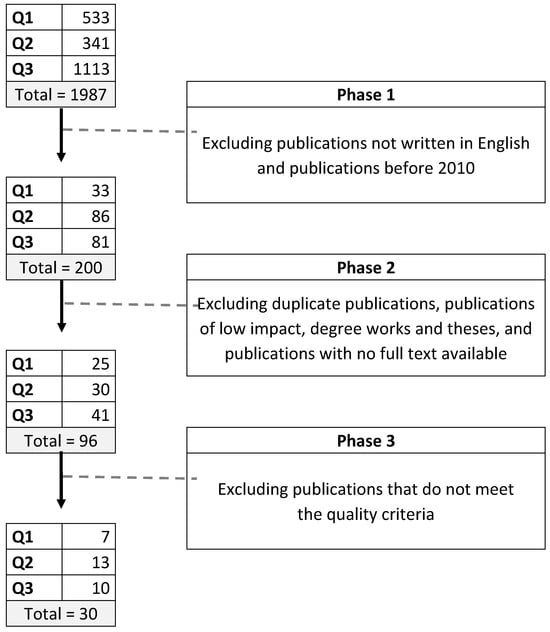
Figure 1
Open AccessArticle
E-Exam Cheating Detection System for Moodle LMS
by
Ahmed S. Shatnawi, Fahed Awad, Dheya Mustafa, Abdel-Wahab Al-Falaky, Mohammed Shatarah and Mustafa Mohaidat
Information 2025, 16(5), 388; https://doi.org/10.3390/info16050388 - 7 May 2025
Abstract
►▼
Show Figures
The rapid growth of online education has raised significant concerns about identifying and addressing academic dishonesty in online exams. Although existing solutions aim to prevent and detect such misconduct, they often face limitations that make them impractical for many educational institutions. This paper
[...] Read more.
The rapid growth of online education has raised significant concerns about identifying and addressing academic dishonesty in online exams. Although existing solutions aim to prevent and detect such misconduct, they often face limitations that make them impractical for many educational institutions. This paper introduces a novel online education integrity system utilizing well-established statistical methods to identify academic dishonesty. The system has been developed and integrated as an open-source Moodle plug-in. The evaluation involved utilizing an open-source Moodle quiz log database and creating synthetic benchmarks that represented diverse forms of academic dishonesty. The findings indicate that the system accurately identifies instances of academic dishonesty. The anticipated deployment includes institutions that rely on the Moodle Learning Management System (LMS) as their primary platform for administering online exams.
Full article

Figure 1
Open AccessArticle
Human-Centered AI and the Future of Translation Technologies: What Professionals Think About Control and Autonomy in the AI Era
by
Miguel A. Jiménez-Crespo
Information 2025, 16(5), 387; https://doi.org/10.3390/info16050387 - 7 May 2025
Abstract
Two key pillars of human-centered AI (HCAI) approaches are “control” and “autonomy”. To date, little is known about professional translators’ attitudes towards these concepts in the AI era. This paper explores this issue through a survey study of US-based professional translators in mid-2024.
[...] Read more.
Two key pillars of human-centered AI (HCAI) approaches are “control” and “autonomy”. To date, little is known about professional translators’ attitudes towards these concepts in the AI era. This paper explores this issue through a survey study of US-based professional translators in mid-2024. Methodologically, this paper presents a qualitative analysis of open-ended questions through thematic coding to identify themes related to (1) present conceptualizations of control and autonomy over translation technologies, (2) future attitudes towards control and autonomy in the AI era, (3) main threats and challenges, and (4) recommendations to developers to enhance perceptions of control and autonomy. The results show that professionals perceive control and autonomy differently in both the present and the future. The main themes are usability, the ability to turn on and off technologies or reject jobs that require specific technologies, collaboration with developers, and differences in working with LSPs versus private clients. In terms of future attitudes, the most frequent ones are post-editing, quality, communicating or informing clients, LSPs or society at large, and creativity or rates. Overall, the study helps identify how professionals conceptualize control and autonomy and what specific issues could help foster the development of truly human-centered AI in the translation profession.
Full article
(This article belongs to the Special Issue Human and Machine Translation: Recent Trends and Foundations)
Open AccessArticle
DDA-MSLD: A Multi-Feature Speech Lie Detection Algorithm Based on a Dual-Stream Deep Architecture
by
Pengfei Guo, Shucheng Huang and Mingxing Li
Information 2025, 16(5), 386; https://doi.org/10.3390/info16050386 - 6 May 2025
Abstract
►▼
Show Figures
Speech lie detection is a technique that analyzes speech signals in detail to determine whether a speaker is lying. It has significant application value and has attracted attention from various fields. However, existing speech lie detection algorithms still have certain limitations. These algorithms
[...] Read more.
Speech lie detection is a technique that analyzes speech signals in detail to determine whether a speaker is lying. It has significant application value and has attracted attention from various fields. However, existing speech lie detection algorithms still have certain limitations. These algorithms fail to fully explore manually extracted features based on prior knowledge and also neglect the dynamic characteristics of speech as well as the impact of temporal context, resulting in reduced detection accuracy and generalization. To address these issues, this paper proposes a multi-feature speech lie detection algorithm based on the dual-stream deep architecture (DDA-MSLD).This algorithm employs a dual-stream structure to learn different types of features simultaneously. Firstly, it combines a gated recurrent unit (GRU) network with the attention mechanism. This combination enables the network to more comprehensively capture the context of speech signals and focus on the parts that are more critical for lie detection. It can perform in-depth sequence pattern analysis on manually extracted static prosodic features and nonlinear dynamic features, obtaining high-order dynamic features related to lies. Secondly, the encoder part of the transformer is used to simultaneously capture the macroscopic structure and microscopic details of speech signals, specifically for high-precision feature extraction of Mel spectrogram features of speech signals, obtaining deep features related to lies. This dual-stream structure processes various features of speech simultaneously, describing the subjective state of speech signals from different perspectives and thereby improving detection accuracy and generalization. Experiments were conducted on the multi-person scenario lie detection dataset CSC, and the results show that this algorithm outperformed existing state-of-the-art algorithms in detection performance. Considering the significant differences in lie speech in different lying scenarios, and to further evaluate the algorithm’s generalization performance, a single-person scenario Chinese lie speech dataset Local was constructed, and experiments were conducted on it. The results indicate that the algorithm has a strong generalization ability in different scenarios.
Full article
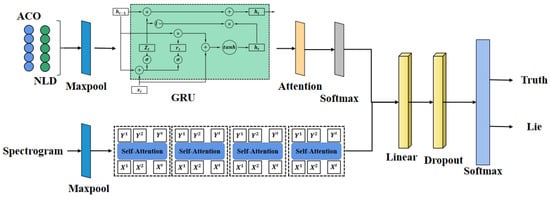
Figure 1
Open AccessArticle
Extended Model for Efficient Federated Identity Management with Dynamic Levels of Assurance Across eIDAS, REFEDS, and Kantara Frameworks for Educational Institutions
by
Vjollca Shemshi and Boro Jakimovski
Information 2025, 16(5), 385; https://doi.org/10.3390/info16050385 - 6 May 2025
Abstract
The electronic identity (eID) concept plays a crucial role in building trust and security in electronic transactions and communications. In federated systems, where multiple organizations and users share and use common resources, effective identity management is critical. In this context, the use of
[...] Read more.
The electronic identity (eID) concept plays a crucial role in building trust and security in electronic transactions and communications. In federated systems, where multiple organizations and users share and use common resources, effective identity management is critical. In this context, the use of an identity provider proxy (IdP proxy) has the potential to facilitate and enhance the interoperability and security of electronic identities. This research examines the role, benefits, and challenges of using an IdP proxy in federated systems. Additionally, this study focuses on the use of IdP proxies for the management of electronic identities in federated systems and compares the approaches and practices employed in three significant frameworks: eIDAS (electronic identification, authentication, and trust services), REFEDS (research and education federations), and the Kantara Initiative. Considering the identity architectures of the eIDAS, REFEDS, and Kantara frameworks—each of which exhibits special and unique features—as a reference point to analyze identity attributes, we use the AARC blueprint model, the main component of which is the IdP proxy, as an intermediary for the management of identity attributes.
Full article
(This article belongs to the Section Information Security and Privacy)
►▼
Show Figures

Figure 1
Open AccessArticle
A Modified Selected Mapping Scheme for Peak-to-Average Power Ratio Reduction in Polar-Coded Orthogonal Frequency-Division Multiplexing Systems
by
Chao Xing, Nixi Chen Hu and Ana García Armada
Information 2025, 16(5), 384; https://doi.org/10.3390/info16050384 - 6 May 2025
Abstract
This paper proposes a modified polar coding-based selected mapping (PC-SLM) scheme to reduce the peak-to-average power ratio (PAPR) in orthogonal frequency-division multiplexing (OFDM) systems. In the proposed transmitter, modulated signal vector for a subset of frozen bits, termed PAPR bits, are precomputed, enabling
[...] Read more.
This paper proposes a modified polar coding-based selected mapping (PC-SLM) scheme to reduce the peak-to-average power ratio (PAPR) in orthogonal frequency-division multiplexing (OFDM) systems. In the proposed transmitter, modulated signal vector for a subset of frozen bits, termed PAPR bits, are precomputed, enabling a single polar encoder and modulator to generate multiple modulation symbols, thereby significantly reducing the hardware complexity compared to existing PC-SLM schemes. To achieve side information (SI)-free transmission, a novel belief propagation (BP)-based receiver is introduced, incorporating a G-matrix-based early termination criterion and a frozen bit check (BP-GF) for joint detection and decoding. Simulation results show that the proposed scheme significantly reduces PAPR across various code lengths, with greater gains as the number of PAPR bits increases. Furthermore, for PC-SLM schemes employing the partially frozen bit method, the BP-GF-based receiver achieves a PAPR reduction and error correction performance comparable to that of the successive cancellation (SC)-based receiver. Additionally, the BP-GF-based receiver exhibits lower decoding latency than the successive cancellation list (SCL)-based receiver.
Full article
(This article belongs to the Section Information and Communications Technology)
►▼
Show Figures
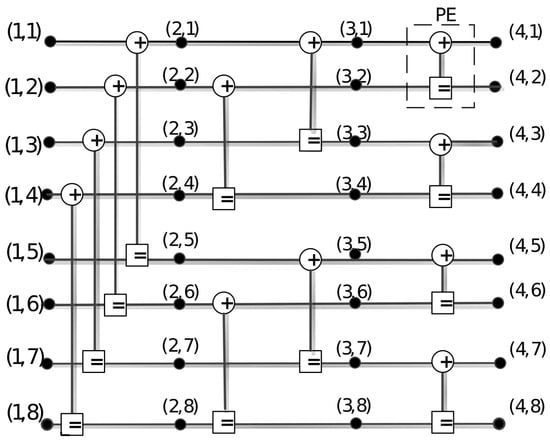
Figure 1
Open AccessArticle
iSight: A Smart Clothing Management System to Empower Blind and Visually Impaired Individuals
by
Daniel Rocha, Celina P. Leão, Filomena Soares and Vítor Carvalho
Information 2025, 16(5), 383; https://doi.org/10.3390/info16050383 - 3 May 2025
Abstract
Clothing management is a major challenge for blind and visually impaired individuals to perform independently. This research developed and validated the iSight, a mechatronic smart wardrobe prototype, integrating computer vision and artificial intelligence to identify clothing types, colours, and alterations. Tested with 15
[...] Read more.
Clothing management is a major challenge for blind and visually impaired individuals to perform independently. This research developed and validated the iSight, a mechatronic smart wardrobe prototype, integrating computer vision and artificial intelligence to identify clothing types, colours, and alterations. Tested with 15 participants, iSight achieved high user satisfaction, with 60% rating it as very accurate in clothing identification, 80% in colour detection, and 86.7% in near-field communication tag recognition. Statistical analyses confirmed its positive impact on confidence, independence, and well-being. Despite the fact that improvements in menu complexity and fabric information were suggested, iSight proves to be a robust, user-friendly assistive tool with the potential to enhance the daily living of blind and visually impaired individuals.
Full article
(This article belongs to the Special Issue AI-Based Image Processing and Computer Vision)
►▼
Show Figures
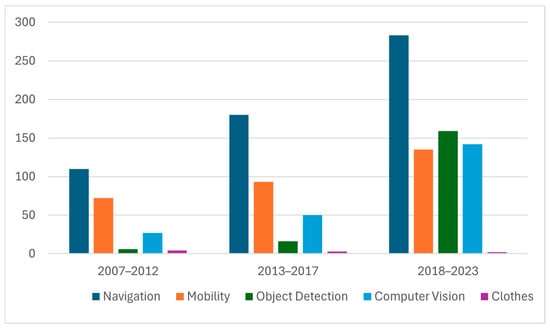
Figure 1
Open AccessArticle
Improved U-Net for Precise Gauge Dial Segmentation in Substation Inspection Systems: A Study on Enhancing Accuracy and Robustness
by
Wan Zou, Yiping Jiang, Wenlong Liao, Songhai Fan, Yueping Yang, Jin Hou and Hao Tang
Information 2025, 16(5), 382; https://doi.org/10.3390/info16050382 - 3 May 2025
Abstract
►▼
Show Figures
In practical applications, the clarity of analog dial images is often compromised due to factors such as lighting conditions, leading to low precision and poor segmentation of dial scales and pointers. This results in segmentation outcomes that fail to meet the real-time requirements
[...] Read more.
In practical applications, the clarity of analog dial images is often compromised due to factors such as lighting conditions, leading to low precision and poor segmentation of dial scales and pointers. This results in segmentation outcomes that fail to meet the real-time requirements of substation inspection systems. To address these challenges, we propose an improved U-Net segmentation algorithm. The key innovation of our approach is the insertion of a layer-hopping connection module between the Encoder and Decoder to capture feature information across multiple scales, enhancing semantic expressiveness and optimizing feature fusion. Additionally, we replace traditional convolution operations with wavelet convolution, which improves the network’s ability to capture low-frequency information, essential for understanding the overall dial structure. An adaptive attention mechanism is also incorporated in the upsampling stage of the network, enabling the model to dynamically focus on salient features, further improving generalization. These improvements enable the network to more accurately detect target regions within dial images, significantly enhancing segmentation accuracy and robustness. Experimental results demonstrate that the proposed method outperforms traditional U-Net models in segmentation tasks, achieving superior precision in segmenting scales and pointers, effectively addressing issues of low precision and poor segmentation, and making it suitable for real-time substation inspection systems.
Full article

Figure 1
Open AccessArticle
Amazon Web Service–Google Cross-Cloud Platform for Machine Learning-Based Satellite Image Detection
by
David Pacios, Sara Ignacio-Cerrato, José Luis Vázquez-Poletti, Rafael Moreno-Vozmediano, Nikolaos Schetakis, Konstantinos Stavrakakis, Alessio Di Iorio, Jorge J. Gomez-Sanz and Luis Vazquez
Information 2025, 16(5), 381; https://doi.org/10.3390/info16050381 - 2 May 2025
Abstract
Satellite image analysis is a critical component of Earth observation and satellite data analysis, providing detailed information on the effects of global events such as the COVID-19 pandemic. Cloud computing offers a flexible way to allocate resources and simplifies the management of infrastructure.
[...] Read more.
Satellite image analysis is a critical component of Earth observation and satellite data analysis, providing detailed information on the effects of global events such as the COVID-19 pandemic. Cloud computing offers a flexible way to allocate resources and simplifies the management of infrastructure. In this study, we propose a cross-cloud system for ML-based satellite image detection, focusing on the financial and performance aspects of utilizing Amazon Web Service (AWS) Lambda and Amazon SageMaker for advanced machine learning tasks. Our system utilizes Google Apps Script (GAS) to create a web-based control panel, providing users with access to our AWS-hosted satellite detection models. Additionally, we utilize AWS to manage expenses through a strategic combination of Google Cloud and AWS, providing not only economic advantages, but also enhanced resilience. Furthermore, our approach capitalizes on the synergistic capabilities of AWS and Google Cloud to fortify our defenses against data loss and ensure operational resilience. Our goal is to demonstrate the effectiveness of a cloud environment in addressing complex and interdisciplinary challenges, particularly in the field of object analysis using spatial imagery.
Full article
(This article belongs to the Special Issue Real-World Applications of Machine Learning Techniques)
►▼
Show Figures

Figure 1
Open AccessArticle
Fusion of Aerial and Satellite Images for Automatic Extraction of Building Footprint Information Using Deep Neural Networks
by
Ehsan Haghighi Gashti, Hanieh Bahiraei, Mohammad Javad Valadan Zoej and Ebrahim Ghaderpour
Information 2025, 16(5), 380; https://doi.org/10.3390/info16050380 - 2 May 2025
Abstract
The analysis of aerial and satellite images for building footprint detection is one of the major challenges in photogrammetry and remote sensing. This information is useful for various applications, such as urban planning, disaster monitoring, and 3D city modeling. However, it has become
[...] Read more.
The analysis of aerial and satellite images for building footprint detection is one of the major challenges in photogrammetry and remote sensing. This information is useful for various applications, such as urban planning, disaster monitoring, and 3D city modeling. However, it has become a significant challenge due to the diverse characteristics of buildings, such as shape, size, and shadow interference. This study investigated the simultaneous use of aerial and satellite images to improve the accuracy of deep learning models in building footprint detection. For this purpose, aerial images with a spatial resolution of 30 cm and Sentinel-2 satellite imagery were employed. Several satellite-derived spectral indices were extracted from the Sentinel-2 image. Then, U-Net models combined with ResNet-18 and ResNet-34 were trained on these data. The results showed that the combination of the U-Net model with ResNet-34, trained on a dataset obtained by integrating aerial images and satellite indices, referred to as RGB–Sentinel–ResNet34, achieved the best performance among the evaluated models. This model attained an accuracy of 96.99%, an F1-score of 90.57%, and an Intersection over Union of 73.86%. Compared to other models, RGB–Sentinel–ResNet34 showed a significant improvement in accuracy and generalization capability. The findings indicated that the simultaneous use of aerial and satellite data can substantially enhance the accuracy of building footprint detection.
Full article
(This article belongs to the Special Issue Machine Learning and Artificial Intelligence with Applications)
►▼
Show Figures
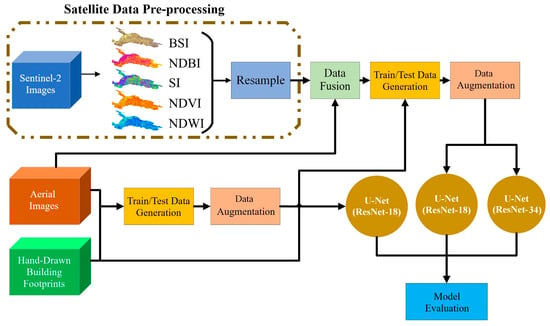
Figure 1
Open AccessArticle
Adaptive Intervention Architecture for Psychological Manipulation Detection: A Culture-Specific Approach for Adolescent Digital Communications
by
Sungwook Yoon and Byungmun Kim
Information 2025, 16(5), 379; https://doi.org/10.3390/info16050379 - 2 May 2025
Abstract
This study introduces a novel artificial intelligence system for detecting and addressing psychological manipulation in digital communications, with a focus on adolescents. The system integrates a hybrid neural network model with emotion analysis capabilities specifically designed for Korean language contexts. Our approach combines
[...] Read more.
This study introduces a novel artificial intelligence system for detecting and addressing psychological manipulation in digital communications, with a focus on adolescents. The system integrates a hybrid neural network model with emotion analysis capabilities specifically designed for Korean language contexts. Our approach combines text analysis with emotion recognition to enhance detection accuracy while implementing a tiered intervention strategy based on risk levels. The system demonstrated significant improvements over baseline models in detecting various forms of psychological manipulation, particularly in identifying subtle patterns. Our expert evaluation suggests the system’s potential effectiveness in protecting adolescent mental health in digital environments. While primarily focused on adolescents, the findings indicate broader applicability across age groups. This research contributes to the field by offering a culturally adapted framework for psychological manipulation detection, a multimodal analytical approach, and an ethically designed intervention system.
Full article
(This article belongs to the Section Information and Communications Technology)
►▼
Show Figures
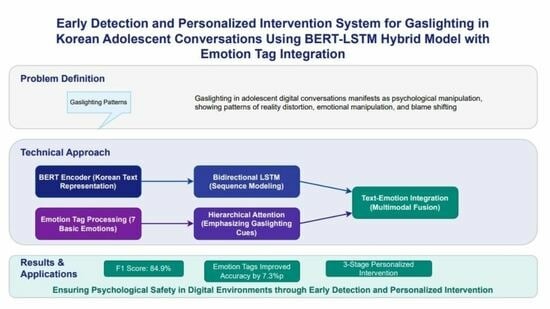
Graphical abstract
Open AccessReview
Large Language Models in Systematic Review Screening: Opportunities, Challenges, and Methodological Considerations
by
Carlo Galli, Anna V. Gavrilova and Elena Calciolari
Information 2025, 16(5), 378; https://doi.org/10.3390/info16050378 - 1 May 2025
Abstract
Systematic reviews require labor-intensive screening processes—an approach prone to bottlenecks, delays, and scalability constraints in large-scale reviews. Large Language Models (LLMs) have recently emerged as a powerful alternative, capable of operating in zero-shot or few-shot modes to classify abstracts according to predefined criteria
[...] Read more.
Systematic reviews require labor-intensive screening processes—an approach prone to bottlenecks, delays, and scalability constraints in large-scale reviews. Large Language Models (LLMs) have recently emerged as a powerful alternative, capable of operating in zero-shot or few-shot modes to classify abstracts according to predefined criteria without requiring continuous human intervention like semi-automated platforms. This review focuses on the central challenges that users in the biomedical field encounter when integrating LLMs—such as GPT-4—into evidence-based research. It examines critical requirements for software and data preprocessing, discusses various prompt strategies, and underscores the continued need for human oversight to maintain rigorous quality control. By drawing on current practices for cost management, reproducibility, and prompt refinement, this article highlights how review teams can substantially reduce screening workloads without compromising the comprehensiveness of evidence-based inquiry. The findings presented aim to balance the strengths of LLM-driven automation with structured human checks, ensuring that systematic reviews retain their methodological integrity while leveraging the efficiency gains made possible by recent advances in artificial intelligence.
Full article
(This article belongs to the Special Issue Semantic Web and Language Models)
►▼
Show Figures

Figure 1
Open AccessArticle
Multi-View Intrusion Detection Framework Using Deep Learning and Knowledge Graphs
by
Min Li, Yuansong Qiao and Brian Lee
Information 2025, 16(5), 377; https://doi.org/10.3390/info16050377 - 1 May 2025
Abstract
Traditional intrusion detection systems (IDSs) rely on static rules and one-dimensional features, and they have difficulty dealing with zero-day attacks and highly concealed threats; furthermore, mainstream deep learning models cannot capture the correlation between multiple views of attacks due to their single perspective.
[...] Read more.
Traditional intrusion detection systems (IDSs) rely on static rules and one-dimensional features, and they have difficulty dealing with zero-day attacks and highly concealed threats; furthermore, mainstream deep learning models cannot capture the correlation between multiple views of attacks due to their single perspective. This paper proposes a knowledge graph-enhanced multi-view deep learning framework, considering the strategy of integrating network traffic, host behavior, and semantic relationships; and evaluates the impact of the secondary fusion strategy on feature fusion to identify the optimal multi-view model configuration. The primary objective is to verify the superiority of multi-view feature fusion technology and determine whether incorporating knowledge graphs (KGs) can further enhance model performance. First, we introduce the knowledge graph (KG) as one of the feature views and neural networks as additional views, forming a multi-view feature fusion strategy that emphasizes the integration of spatial and relational features. The KG represents relational features combined with spatial features extracted by neural networks, enabling a more comprehensive representation of attack patterns through the synergy of both feature types. Secondly, based on this foundation, we propose a two-level fusion strategy. During the representation learning of spatial features, primary fusion is performed of each view, followed by secondary fusion with relational features from KG, thereby deepening and broadening feature integration. These strategies for understanding and deploying the multi-view concept improve the model’s expressive power and detection performance and also demonstrate strong generalization and robustness across three datasets, including TON_IoT and UNSW-NB15, marking a contribution of this study. After experimental evaluation, the F1 scores of multi-view models outperformed single-view models across all three datasets. Specifically, the F1 score of the multi-view approach (Model 6) improved by 10.57% on the TON_IoT Network+Win10 dataset compared with the best single-view model. In contrast, improvements of 5.53% and 3.21% were observed on the TON_IoT network and UNSW-NB15 datasets. In terms of feature fusion strategies, the secondary fusion strategy (Model 6) outperformed primary fusion (Model 5). Furthermore, incorporating KG-based relational features as a separate view improved model performance, a finding validated by ablation studies. Experimental results show that the deep fusion strategy of multi-dimensional data overcomes the limitations of traditional single-view models, enables collaborative multi-dimensional analysis of network attack behaviors, and significantly enhances detection capabilities in complex attack scenarios. This approach establishes a scalable multimodal analysis framework for intelligent cybersecurity, advancing intrusion detection beyond traditional rule-based methods toward semantic understanding.
Full article
(This article belongs to the Special Issue Intrusion Detection Systems in IoT Networks)
►▼
Show Figures

Figure 1
Open AccessArticle
Electric Bus Scheduling Problem with Time Windows and Stochastic Travel Times
by
Vladyslav Kost, Marilena Merakou and Konstantinos Gkiotsalitis
Information 2025, 16(5), 376; https://doi.org/10.3390/info16050376 - 30 Apr 2025
Abstract
This work develops a scheduling tool for electric buses that accounts for daily disruptions while minimizing the operational costs. The contribution of this study lies in the development of electric bus schedules that consider many factors, such as multiple depots, multiple charging stations,
[...] Read more.
This work develops a scheduling tool for electric buses that accounts for daily disruptions while minimizing the operational costs. The contribution of this study lies in the development of electric bus schedules that consider many factors, such as multiple depots, multiple charging stations, and stochastic travel times, providing schedules resilient to extreme conditions. The developed model is a mixed-integer linear program (MILP) with chance constraints. The main decision variables are the assignment of electric vehicles to scheduled trips and charging events to ensure the improved operation of daily services under uncertain conditions. Numerical experiments and a sensitivity analysis based on the variation in travel times are conducted, demonstrating the performance of our solution approach. The results from these experiments indicate that the variant of the model with the chance constraint produces schedules with lower operational costs compared to the case where the chance constraints are not introduced.
Full article
(This article belongs to the Special Issue Emerging Research in Optimization and Machine Learning)
►▼
Show Figures
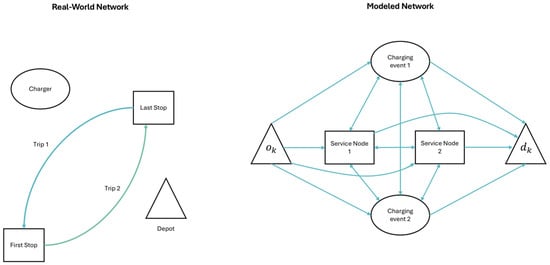
Figure 1
Open AccessArticle
Quantum for All: Using Social Media to Raise Public Awareness of Quantum Technologies
by
Igor Gutorov, Irina Gorelova, Francesco Bellini and Fabrizio D’Ascenzo
Information 2025, 16(5), 375; https://doi.org/10.3390/info16050375 - 30 Apr 2025
Abstract
►▼
Show Figures
Quantum technology has significantly progressed over the last decade. While initially of interest to a narrow circle of professionals and technology enthusiasts, the general public’s knowledge of the developments in this domain, as well as the pitfalls and benefits, is currently considered low.
[...] Read more.
Quantum technology has significantly progressed over the last decade. While initially of interest to a narrow circle of professionals and technology enthusiasts, the general public’s knowledge of the developments in this domain, as well as the pitfalls and benefits, is currently considered low. As quantum innovations are being integrated into strategic agendas on national and supranational levels, initiatives should be undertaken to raise public awareness about these technologies. The present paper examines the current trends of the implementation of social media, and, in particular, Instagram, by supranational organizations and initiatives to raise public awareness of quantum technology advancements. This research conducts an analysis of topical messages from the Instagram accounts of the International Year of Quantum Science and Technology (IYQ), the United Nations Educational, Scientific and Cultural Organization (UNESCO), and the European Commission account for Digital EU. The study highlights the patterns of social media communication by supranational organizations and initiatives on quantum technologies’ properties and provides reflections on the future research avenues to explore public awareness of this disruptive technology. The findings serve as the basis for further research on various aspects of public outreach to inform about the quantum evolution and its potential impact on society, economy, and future digital transformation developments.
Full article
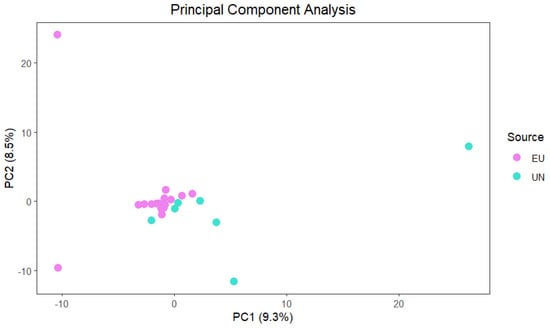
Figure 1
Open AccessArticle
How Human–Robot Interaction Can Influence Task Performance and Perceived Cognitive Load at Different Support Conditions
by
Simone Varrasi, Roberto Vagnetti, Nicola Camp, John Hough, Alessandro Di Nuovo, Sabrina Castellano and Daniele Magistro
Information 2025, 16(5), 374; https://doi.org/10.3390/info16050374 - 30 Apr 2025
Abstract
Cognitive load refers to the mental resources used for executing simultaneous tasks. Since these resources are limited, individuals can only process a specific amount of information at a time. Daily activities often involve mentally demanding tasks, which is why social robots have been
[...] Read more.
Cognitive load refers to the mental resources used for executing simultaneous tasks. Since these resources are limited, individuals can only process a specific amount of information at a time. Daily activities often involve mentally demanding tasks, which is why social robots have been proposed to simplify them and support users. This study aimed to verify whether and how a social robot can enhance the performance and support the management of cognitive load. Participants completed a baseline where a cognitive activity was carried out without support, and three other conditions where similar activities of increasing difficulty were collaboratively made with the NAO robot. In each condition, errors, time, and perceived cognitive load were measured. Results revealed that the robot improved performance and perceived cognitive load when compared to the baseline, but this support was then thwarted by excessive levels of cognitive load. Future research should focus on developing and designing collaborative human–robot interactions that consider the user’s mental demand, to promote effective and personalized robotic help for independent living.
Full article
(This article belongs to the Special Issue Multimodal Human-Computer Interaction)
►▼
Show Figures
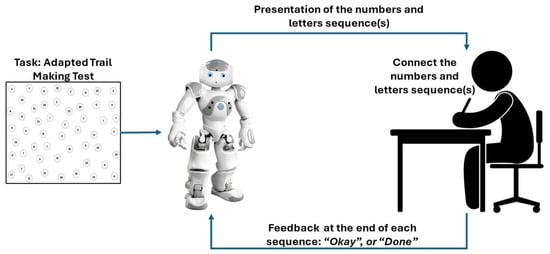
Figure 1

Journal Menu
► ▼ Journal Menu-
- Information Home
- Aims & Scope
- Editorial Board
- Reviewer Board
- Topical Advisory Panel
- Instructions for Authors
- Special Issues
- Topics
- Sections & Collections
- Article Processing Charge
- Indexing & Archiving
- Editor’s Choice Articles
- Most Cited & Viewed
- Journal Statistics
- Journal History
- Journal Awards
- Society Collaborations
- Conferences
- Editorial Office
Journal Browser
► ▼ Journal BrowserHighly Accessed Articles
Latest Books
E-Mail Alert
News
Topics
Topic in
AI, Applied Sciences, Education Sciences, Electronics, Information
Explainable AI in Education
Topic Editors: Guanfeng Liu, Karina Luzia, Luke Bozzetto, Tommy Yuan, Pengpeng ZhaoDeadline: 30 June 2025
Topic in
AI, Applied Sciences, BDCC, Sensors, Information, IJGI
Applied Computing and Machine Intelligence (ACMI)
Topic Editors: Chuan-Ming Liu, Wei-Shinn KuDeadline: 31 July 2025
Topic in
Algorithms, BDCC, BioMedInformatics, Information, Mathematics
Machine Learning Empowered Drug Screen
Topic Editors: Teng Zhou, Jiaqi Wang, Youyi SongDeadline: 31 August 2025
Topic in
Information, Mathematics, MTI, Symmetry
Youth Engagement in Social Media in the Post COVID-19 Era
Topic Editors: Naseer Abbas Khan, Shahid Kalim Khan, Abdul QayyumDeadline: 30 September 2025

Conferences
Special Issues
Special Issue in
Information
Text-to-Speech and AI Music
Guest Editor: Xulong ZhangDeadline: 14 May 2025
Special Issue in
Information
Machine Learning and Artificial Intelligence with Applications
Guest Editors: Jae-Mo Kang, Vikas PalakondaDeadline: 31 May 2025
Special Issue in
Information
New Information Communication Technologies in the Digital Era
Guest Editors: Martin Wynn, Jose IrizarDeadline: 31 May 2025
Special Issue in
Information
Intelligent Agent and Multi-Agent System
Guest Editor: Katsuhide FujitaDeadline: 31 May 2025
Topical Collections
Topical Collection in
Information
Knowledge Graphs for Search and Recommendation
Collection Editors: Pierpaolo Basile, Annalina Caputo
Topical Collection in
Information
Augmented Reality Technologies, Systems and Applications
Collection Editors: Ramon Fabregat, Jorge Bacca-Acosta, N.D. Duque-Mendez
Topical Collection in
Information
Natural Language Processing and Applications: Challenges and Perspectives
Collection Editor: Diego Reforgiato Recupero








